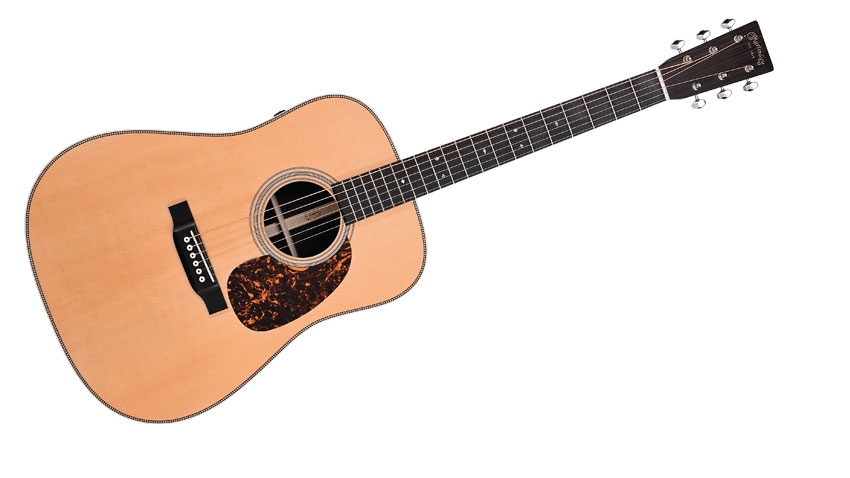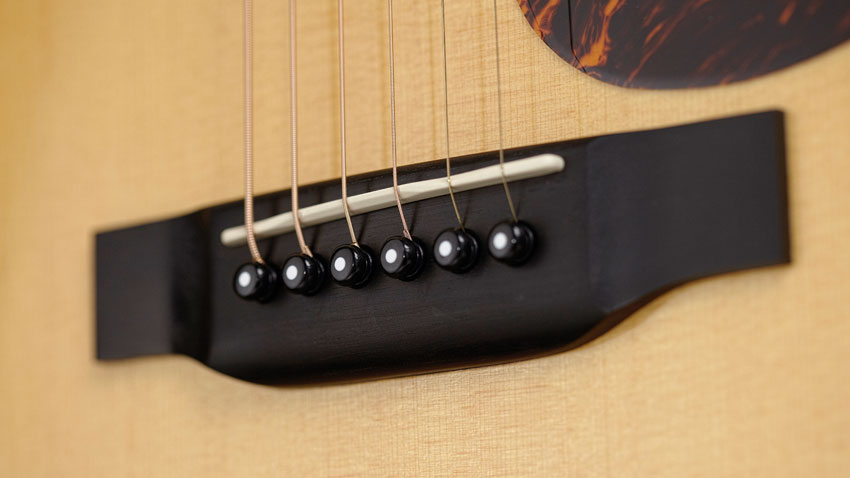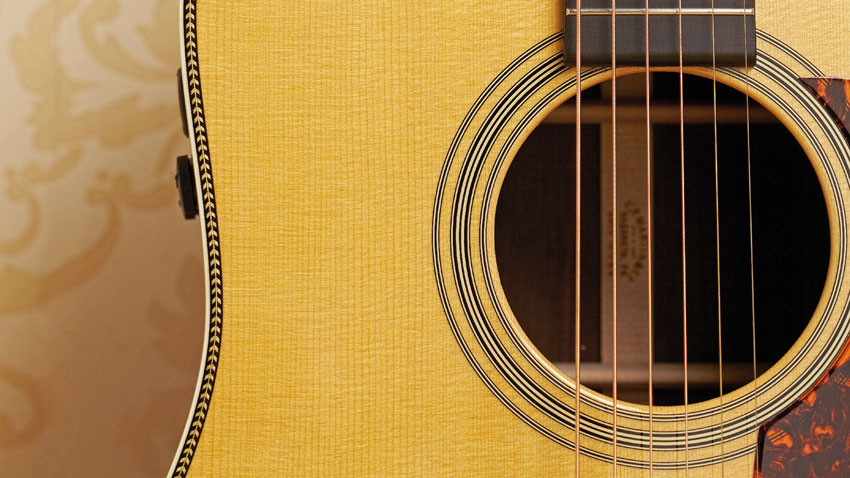MusicRadar Verdict
One of the most exciting and rewarding electros Martin has produced in recent times.
Pros
- +
Everything!
Cons
- -
Nothing... except perhaps the price.
MusicRadar's got your back

Martin Retro Series HD-28E

Preamp

Bridge

Finish
Martin's new Retro Series promises time-travelling guitar tones in an electro-acoustic package. We take a look at its stunning reworking of a 1934 long-scale 000-28 model.
As well as a visitors' centre, pickin' parlour and factory, Martin Guitars' HQ in Nazareth, Pennsylvania boasts a museum, which plots the firm's 175-year history interwoven through American culture.
Among the 170-plus guitars on display are iconic, classic Martins from the 30s and 40s - known as the 'Golden Era' of guitar making. It's these unique, highly valuable guitars that form the lifeblood of Martin's new Retro Series of electro guitars.
Martin Guitars and Fishman Electronics have enjoyed a collaborative association for over 20 years. During a brainstorming session in early 2011, Martin CEO Chris Martin put forward the idea of recording some of the museum's pre-war Martins to Larry Fishman, CEO of Fishman Electronics.
As Chris Martin himself says: "All of the guitars in the museum are great-sounding guitars, but some are spectacular." This is because they possess unique tonal characteristics attributed to the passing of time.
"The concept was simple: to record selected 'Golden Era' guitars and turn the recordings into software that could be read by Fishman's preamps"
The concept was simple: to record selected 'Golden Era' guitars and, in a similar way to the earlier Aura series of Martin electros (which reproduces the studio-mic'd sound of a guitar), turn the recordings into software that could be read by Fishman's preamps, thereby offering access to the sounds of these vintage instruments.
The 'tone donors' used included a 1942 D-45, a 1941 D-28, a 1937 D-18 and (on loan from Vintage Instruments) a 1934 long-scale 000-28 model. If the project was successful, then plugging in the resulting guitars would be the closest thing we could get to acoustic time travel.
The project employed the services of Grammy Award-winning producer and acoustic recording guru, Bill VornDick, and his famed Mountainside Studios in Nashville. He assembled a collection of vintage and boutique microphones - some dating back to the 1930s - and began painstakingly and meticulously recording the museum pieces.
The results were then passed to Fishman who, forging a new technology path, set about turning the recordings into software readable by its F1 Aura preamp systems.
"The retro look comes courtesy of ageing toner applied to the solid Sitka top; a silk screen decal on the classic Martin headplate; butterbean tuners; and a 1930s-style ebony bridge."
Phase three involved Martin creating an all-new series of non-cutaway electros, vintage in appearance but benefiting from the enhanced playability of recent Martin models, with features such as the Performing Artist Series high-performance neck and its reshaped taper and low-oval profile.
In terms of the guitars' dimensions, the review model you see here is identical, though its neck profile differentiates it from a 'standard' Martin dreadnought. The retro look comes courtesy of ageing toner applied to the solid Sitka top; a silk screen decal on the classic Martin headplate; butterbean open-geared tuners; and a 1930s-style ebony bridge.
Interestingly, while traditional bone has been used for the nut, Graph Tech's Tusq is the chosen material for the compensated saddle. This is because Tusq, apparently, transfers string vibration to the undersaddle pickup much more evenly than bone - a prerequisite for an electro whose amplified performance is all about delicate tonal inflections and nuances.
The Fishman Aura Plus preamp system is not new to the marketplace, having been previously featured on Performing Artist series guitars. As fitted here, the Aura Plus system has two distinct modes of operation: Easy and Performance.
As you'd expect, Easy mode is a simple, uncomplicated way of getting amplified, offering three pre-selected, pre-blended images, identified by a simple 1, 2 or 3 on the 18mm diameter display LED.
Pressing the left Edit button scrolls through these presets. Pressing a fourth time takes you to 'P', which, in Easy mode, denotes an unblended, pickup-only signal. Tone shaping in Easy mode is limited with just the Edit button offering a mid-scoop/boost.
Unfortunately, due to its multi-functionality, the Edit rotary has no limit, either left or right, so it can be a little difficult orientating where the control is set, particularly on a dimly lit stage.
"Navigating around the menus does take time to get to grips with, but is well worth the effort, because the tone-shaping options on offer here are wide-ranging and rewarding"
This is not the case with the right volume control, which also engages the tuner (whether or not the guitar is plugged in). Sharps are indicated by a tiny dot in the top-left-hand corner of the display, which is also not the easiest to see unless you drop the headstock away from you, squaring the display up to your line of sight.
Performance mode is engaged by holding down the Edit button while inserting a cable into the standard jack output located just behind the strap button. Here, the full capabilities of the F1 Aura Plus shine, giving us access to blend, bass, mid, treble, a compressor and its 'search and destroy' anti-feedback system.
Navigating around the menus does take time to get to grips with, but putting in the time is well worth the effort, because the tone-shaping options on offer here are wide-ranging, impressive and rewarding. Mercifully, for those who like to 'fiddle', restoring factory resets is an easy procedure, and erases any alterations made in Performance mode.
The power-hungry Aura Plus system uses up a fully charged nine-volt battery in a little over 24 hours. We like that the battery is not anchored inside the compartment and, once the compartment door is opened, it slides out easily.
As you'd expect with a £2,000-plus Martin, the build quality, attention to detail and overall presentation is excellent. The label-free inside is clean and tidy, every joint is crisp, and the gloss finish is flawless.
Build
With its herringbone purfling, ornate centre strip to the back, and white bridge pins, the HD-28E carries more of a 'retro' feel than it's previously reviewed sister model, the Martin Retro Series D-18E. When added to the rich, grain-prominent rosewood back and sides, there's a sense of acoustic royalty.
Boasting extremely high standards of craftsmanship and finish, from every angle the HD-28E is a stunningly impressive guitar.
Sounds
"Acoustically, the HD-28E offers a mellow, lush and overall richer timbre that makes it very hard to put down"
Acoustically, the HD-28E offers a mellow, lush and overall richer timbre that makes it very hard to put down. Yes, it sounds a little 'new' right now, but even so, its sheer richness and depth has a maturity and warmth that's impossible not to enjoy.
Engaging the Aura Plus in Easy mode offers full, rich, slightly bass-heavy outputs, but with varying degrees of attack and presence. In particular, when selecting 'P' we find the pickup output offers more warmth than in the corresponding setting on the aforementioned D-18E.
The other notable differences between the amplified characteristics of both guitars are in Performance mode, when blending in the pickup signal. The HD-28E possesses more depth and 'plump' than the D-18E, thus affecting the blended output, which is particularly noticeable when the blend is biased to the pickup. Overall, the HD-28E is a highly impressive electro, capable of a wide range of amplified tones suitable for just about any style.
"Though it costs a considerable amount, the HD-28E appears to have it all: timeless styling, a beautiful acoustic voice and fantastic electro sounds"
Without the original Golden Era guitar to hand, we can't make an accurate judgement on how closely the F1 Aura Plus replicates that museum piece. We can, however, confirm that this guitar is an exceptional electro.
Though it costs a considerable amount, the HD-28E appears to have it all: timeless styling, a beautiful acoustic voice and fantastic electro sounds, despite some on-stage practicality issues with the tuner.
Martin's Retro series is aimed at more traditionally-minded players than its Performing Artist series, and will excel in any home or any studio. Its tones work superbly in a live environment, too, though how many people will realistically submit such finery to regular gigging life remains to be seen.
In any case, top marks to Martin and Fishman for travelling back in time to create a forward-thinking guitar worthy of anyone's collection.
Steve Harvey is senior content producer for Pro Sound News and also contributes to other Future brands. He has worked in the pro audio industry — as a touring musician as well as in live production, installed sound, and equipment sales and marketing — since November 1980.
“Sometimes I am two people. Johnny is the nice one. Cash causes all the trouble. They fight”: How Johnny Cash drew on his own experiences to make his greatest songs
“For those on the hunt for a great quality 12-string electro-acoustic that won’t break the bank, it's a no-brainer”: Martin X Series Remastered D-X2E Brazilian 12-String review
“I have that on more records than anything else”: Take a peek inside Vaughn Oliver’s studio









